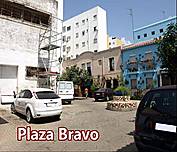USER Partners in Riga to Discuss Safer Public Spaces
Edited on
06 February 2015Safety in public spaces is usually understood in terms of policing, i.e. safety from physical assault, video surveillance and the presence of police officers. But the USER URBACT project wants to go further and look at the feeling of insecurity that users can experience in public spaces, whether or not there are objective grounds for that feeling. How do we design public spaces in which users will not feel afraid? What uses should we support so that public spaces are conducive to socializing, and not a source of anxiety? These are the questions that were discussed at the second USER thematic seminar in Riga which revolved around the presentation by Paul Landauer, a French architect specialised in safety in open spaces. Learn more on this project and its on-going activities.

The USER Project partners explain that the feeling of insecurity influences people's behaviour and whether or not they want to use a public space.
To make people feel safe, the urban aspect and the human aspect are intertwined. A public space that is poorly maintained, confined or, on the contrary, too exposed is a source of anxiety. Similarly, a well-used public space in which people socialize is often a public space that works well. "We need to address both of these aspects to make users feel safe, and not consider only the material aspect, as is often the case."
“We have to strike the right balance between the objective need to make spaces safe, the need to keep them attractive even so, and the need to make users feel more responsible for the way public spaces are used.", they explain.
The photos below illustrate this problem. (Photos: Paul Landauer) Malaga. Can the image of insecurity conveyed by the damaged building facades be rectified by making the owner-inhabitants feel more responsible?
Malaga. Can the image of insecurity conveyed by the damaged building facades be rectified by making the owner-inhabitants feel more responsible?
 Istanbul. The way the benches are laid out in public spaces is a way of controlling social interaction and whether people stop in the space: when benches are scarce, there is little social interaction and people do not stay long. How many benches should there be, and how should they be laid out to ensure that a public space works well from a social viewpoint?
Istanbul. The way the benches are laid out in public spaces is a way of controlling social interaction and whether people stop in the space: when benches are scarce, there is little social interaction and people do not stay long. How many benches should there be, and how should they be laid out to ensure that a public space works well from a social viewpoint?
 Copenhagen. "Eyes on the street" (Jane Jacobs): the feeling of safety in an open space also depends on the fact that people can see what is going on in the street, especially from neighbouring buildings.
Copenhagen. "Eyes on the street" (Jane Jacobs): the feeling of safety in an open space also depends on the fact that people can see what is going on in the street, especially from neighbouring buildings.
An over-emphasis on safety: is over-regulating usage likely to restrict and discourage usage and social interaction? How can we make users feel more responsible for how public spaces are used, instead of relying on physical measures?
The overwhelming conclusion of the discussions at the Riga seminar was that "we should first think about how to get people to use public space together, instead of immediately thinking of physical measures to make it safer".
Walking diagnosis
Participants were able to apply the observation method known as a "walking diagnosis". This is a method used to observe, on the spot, how a particular location is used and how the location could be improved, and to build a diagnosis that all of the stakeholders agree on.
The purpose of a walking diagnosis is "to learn to see together". In a public space, for example, the aim is to gather local residents, users, public space managers, public policy-makers, elected representatives, etc. in order to observe the public space together. Their observation can focus on: how the spaces are designed and equipped, the urban atmospheres; management of urban space, housing and facilities; uses, practices, signs of social life, etc.
During the visit, participants each note their observations on an observation grid.
They then discuss their observations and build a shared diagnosis of the site's improvement points and potential. Because it was drawn up collectively, this shared diagnosis proves to be a very solid basis for designing actions in the future.
Read more :
- USER - URBACT website
 Download USER Newsletter 3 (3.27 MB) - PDF
Download USER Newsletter 3 (3.27 MB) - PDF
Submitted by admin on
